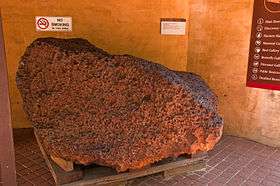Mundrabilla (meteorite)
| Mundrabilla | |
|---|---|
|
Mundrabilla main mass | |
| Type | Iron |
| Structural classification | Medium octahedrite |
| Group | IAB |
| Composition | Meteoric iron (Fe about 90%, Ni 7.8%, Co 0.48%) |
| Country | Australia |
| Region | Western Australia |
| Coordinates | 30°47′S 127°33′E / 30.783°S 127.550°ECoordinates: 30°47′S 127°33′E / 30.783°S 127.550°E[1] |
| Observed fall | No |
| Found date | 1911 |
| TKW | 24 metric tons (24 long tons; 26 short tons)[1] |
Mundrabilla is an iron meteorite found in 1911 in Australia.[1] This is one of the largest meteorites ever found: the Meteoritical Bulletin Database reports a total known weight of 24 t[1] and the main mass (the single largest fragment) accounts for 9980 kg.[2]

History
In 1911 an iron meteorite individual of 112 grams was found by Mr. H. Kent at 31°1′S 127°23′E / 31.017°S 127.383°E in a location of the Nullarbor Plain called Premier Downs. This small meteorite was then called Premier Downs I. Later in 1911 Mr. H. Kent found another small iron meteorite (116 g) about 13 km west from the found location of Premier Downs I: it was called Premier Downs II. Both meteorites were medium octahedrites and Simpson and Bowley (1914) believed that both meteorites were part of the same fall.[3]
In 1918 a third similar small iron meteorite of 99 g was found in the area and it was named Premier Downs III.
Perhaps in 1962 (date is not certain) another small iron of 108 g with similar characteristics was found near Loongana Station by Mr. Harrison. McCall and DeLaeter (1965) suggested a possible pairing with the previous Premier Downs samples.[3]
In 1965 three small iron individuals (94.1 g, 45 g, 38.8 g) were found by W. A. Crowle 16 km north of Mundrabilla Siding at 30°45′S 127°30′E / 30.750°S 127.500°E.
In April 1966 two very large iron masses of 9980 kg and 5440 kg[2] were found in the Nullarbor Plain at 30°47′S 127°33′E / 30.783°S 127.550°E by geologists R. B. Wilson and A. M. Cooney during a geological survey. The two masses were lying 180 metres apart, in clayey soil within very slight depressions. The masses were surrounded by a large number of small iron fragments. These meteorites were called Mundrabilla,[1][3] while the largest fragment, the eleventh largest ever found in the world as of 2012, is distinguished as Mundrabilla I.[4]
In 1967 a small iron (66.5 g) was found at 30°57′S 126°58′E / 30.950°S 126.967°E by W. H. Butler, it was named Loongana Station West.[3]
McCall and Cleverly (1970) suggested that the Mundrabilla meteorites were actually closely related to the Loongana Station and Premier Downs meteorites, and had been shed from the same mass during the atmospheric ablation.
The main mass of 9980 kg is now conserved at the Western Australia Museum.[5]
Composition
This meteorite contains a large fraction of troilite inclusions with graphite and schreibersite as accessory minerals.[3]
Classification
Mundrabilla is classified as part of the IAB group. The IAB group is often viewed as complex of many different groups. In this complex the Mundrabilla and the Waterville meteorite form the "Mundrabilla duo" or "Mundrabilla grouplet" (a group of meteorites with less than 5 members). If three more meteorites with similar properties would be found they could form another group within the IAB complex.[6]
Notes
- 1 2 3 4 5 Meteoritical Bulletin Database: Mundrabilla
- 1 2 http://spaceresearch.nasa.gov/research_projects/meteorite.html
- 1 2 3 4 5 DeLaeter, J. R. The Mundrabilla Meteorite Shower, Meteoritics, volume 7, number 3, page 285.
- ↑ "The World's Largest Meteorites". Meteorite Charts 1. meteoris.de. Retrieved 7 January 2013.
- ↑ Mundrabilla iron meteorite Western Australia Museum
- ↑ Wasson, J.T; Kallemeyn, G.W (30 June 2002). "the IAB iron-meteorite complex: A group, five subgroups, numerous grouplets, closely related, mainly formed by crystal segregation in rapidly cooling melts". Geochimica et Cosmochimica Acta. 66 (13): 2445–2473. doi:10.1016/S0016-7037(02)00848-7.
External links
| Wikimedia Commons has media related to Mundrabilla meteorite. |
- Mundrabilla, IMCA Encyclopedia of Meteorites
